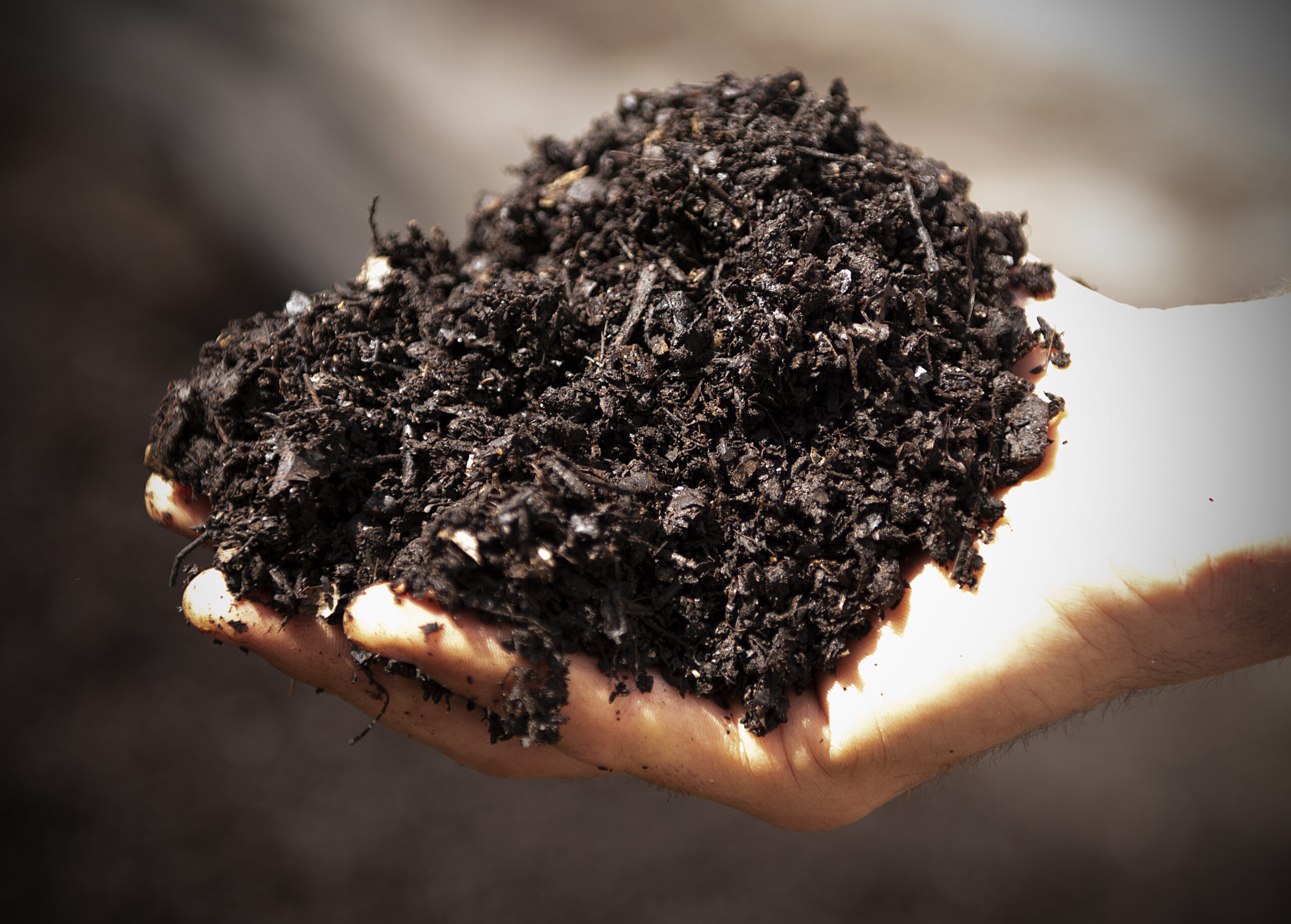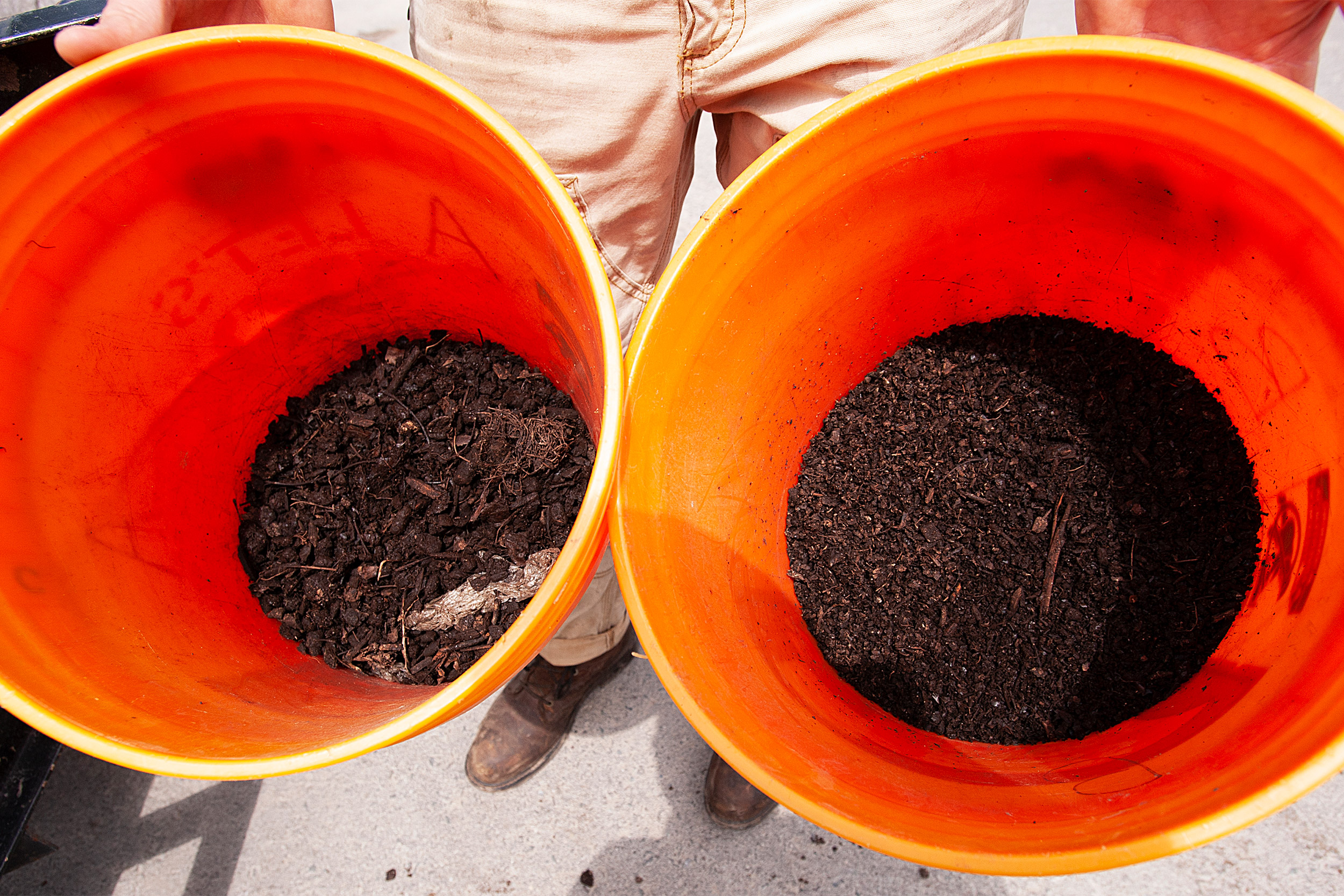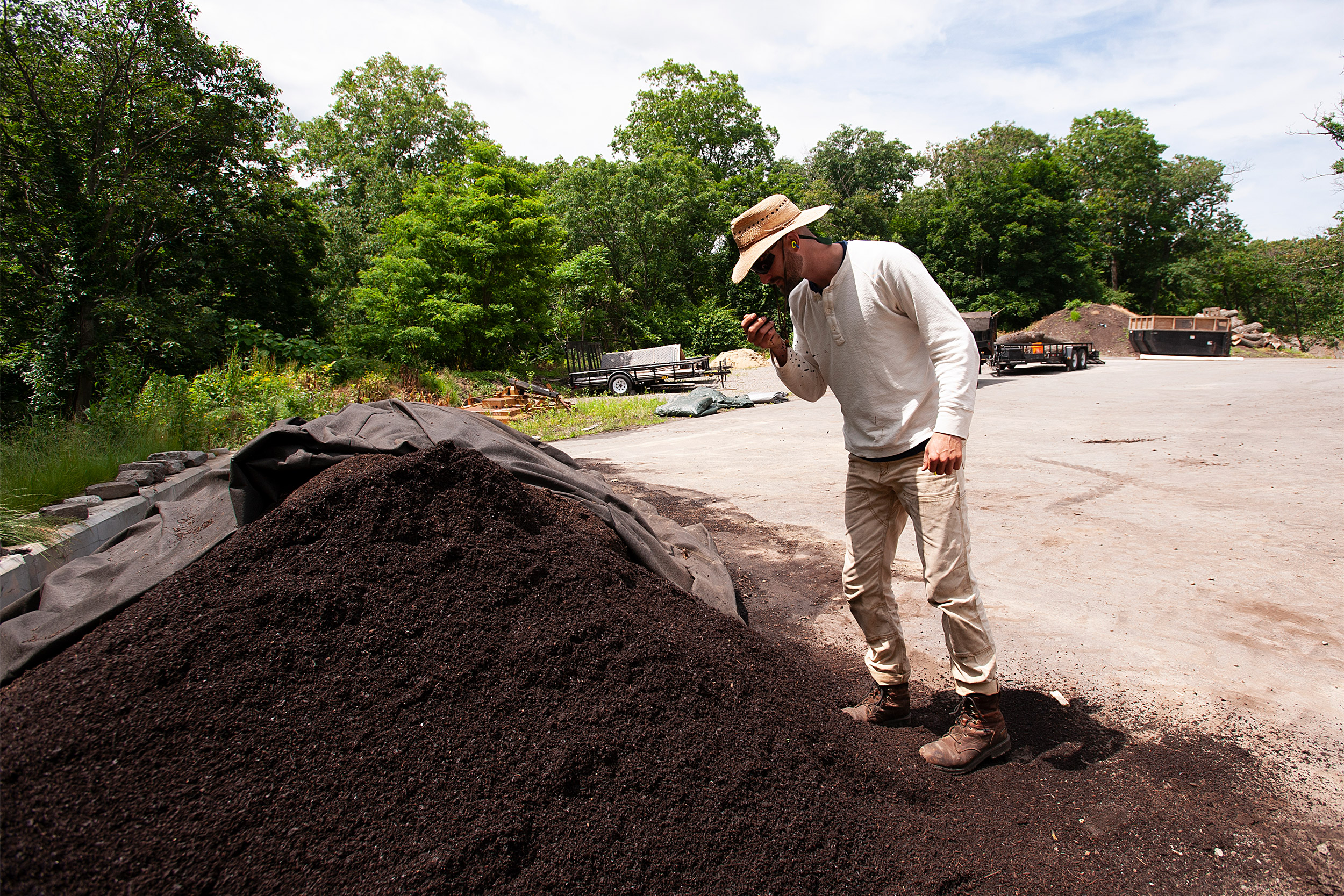
The Arnold Arboretum partners with local businesses to broaden its composting program. Last year, the Arboretum produced more than 20.25 tons of compost.
Photos by Jeffrey Blackwell/Harvard University
It takes a community to make compost
Arnold Arboretum partners with local businesses to turn trash to dark-brown gold
When Conor Guidarelli and Wes Kalloch make their weekly trip to Turtle Swamp Brewing in Jamaica Plain, they’re not on a beer run. The horticulturists have another mission — to make nutrient-rich compost for the plant collections at the Arnold Arboretum of Harvard University.
Besides picking up about 2,000 pounds of wet, spent grain from Turtle Swamp, they also get as much as 40 pounds of used coffee grounds each week from Recreo Coffee in West Roxbury. Both are ingredients in the recipe Guidarelli and Kalloch created in 2018 for the Arboretum’s soil-management program.
The donations from the two local businesses are a considerable contribution to the environmentally sustainable composting program the Arboretum tailored specifically to the needs of its collections. An added benefit: It makes use of organic waste that would otherwise be destined for a landfill.
“This is part of an important initiative at the Arboretum to support small local businesses and become more integrated into our surrounding communities,” said William “Ned” Friedman, Arnold Professor of Organismic and Evolutionary Biology, director of the Arboretum, and a longtime Jamaica Plain resident. “And from a tree’s perspective, what could be better than a mix of coffee and beer spread over your root system?”
Guidarelli, who was hired in 2016 to help guide the soil and composting initiative, said the Arboretum is managing green waste in-house in an environmentally responsible way.
“We are working hard to be more sustainable, to sequester carbon, and improve the organic matter of the soil,” he said.
That’s not an easy task on a 281-acre collection of woody plants from around the world, many of which are members of species threatened with extinction. The horticulture team must address the needs of each species, while keeping an eye on fluctuations in temperature and precipitation, pests, diseases, and other environmental factors.


Bins of compost sit in various stages of processing at the Arnold Arboretum’s green-waste recycling yard. Two buckets show examples of unscreened (left) and screened compost. Screening removes unwanted or large debris and provides consistency in the size of the finished product.
In 2017 the Arboretum formed a Soils Advisory Committee to enhance critical thinking about the long-term health of their soils, collection, and larger environment, according to Andrew Gapinski, head of horticulture. Comprised of soil scientists from North America representing academia, public gardens, and government agencies, including the U.S. Department of Agriculture, the U.S. Forest Service, and the U.S. Department of Agriculture, the committee outlined several initiatives and maintenance practices.
“Our horticulture team is reviewing all aspects of our operations — a continuous cycle of assessment, planning, evaluation, and adjustment to find the most effective care strategies,” Gapinski said. “The composting endeavor is one example of the many innovative solutions underway to find the most effective and sustainable care strategies for the long-term health of the collections and landscape.”
In 2018, the first year of the new system, the Arboretum produced more than 50 cubic yards, or 20.25 tons, of compost, in individual batches of approximately 15 cubic yards. Guidarelli and Kalloch created recipes that blended “browns,” such dead leaves, and “greens,” such as pulled herbaceous weeds, with the spent coffee grounds and beer grains to achieve the carbon and nitrogen ratios needed.
“Composting is both a science and an art, because even when the numbers line up on paper, sometimes when we are looking at an actual batch, we have to throw in another scoop of browns or another scoop of greens,” Guidarelli said. “I like to cook, and this is just large-scale cooking. It’s like solving a puzzle to get your most efficient recipe per batch. It’s a lot of fun.”

But it’s not a “set it and forget it,” he said. It’s a very time and labor-intensive, year-round, active management process. The compost piles go through naturally occurring heating cycles that kill off any weed seeds, plant pests, and diseases, and help determine the stages of the composting process. Guidarelli and Kalloch insert four-foot thermometers into the piles to measure temperature fluctuations, waiting for the pile to get to 130 degrees, the magic number that shows the compost is ready for the next stage.
Another good indicator? Odor. The greens emit methane, which definitely smells bad until the pile has gone through its anaerobic process, and even then may need an adjustment, according to Guidarelli. They turn the piles with a front-end loader to aerate them, or they may add more carbon.
“You just kind of eyeball it with a ratio,” he said. “My mom used to tell me when I was cooking that it’s easier to add than to take away, so I just keep adding little by little until I hit the right mark.”
Nicholas Walther, founder and brewer at Turtle Swamp Brewing, said providing the Arboretum with part of their compost mix is a win-win. Safely disposing of spent grains is a challenge for brewers. In Massachusetts there are strict limits on how much wet waste can go into a dumpster, and Turtle Swamp can generate as much as 1,200 pounds of spent grain material per batch of beer.
“Making this relationship has been amazing, because right when we began production, the Arboretum started its active compost program, processing compost in large quantities at a fast rate,” he said. “From an ecological aspect, this is a really helpful way to keep methane from being released into the atmosphere, so it’s helping the carbon footprint.”
That is what Guidarelli and Kalloch are proudest of — being able to recycle the raw organics they have pulled off the landscape and return nutrient-rich organic matter back to it as their compost is applied to new plantings or trees and shrubs that need extra support.
And yes, try this at home, but with caution. The standard ratio for composting is two parts brown (leaves, mulch, straw, etc.) to one part green (weeds, grass clippings, fruit and vegetable scraps, egg shells, coffee grounds), but Guidarelli warned that the ratio is a starting point: “They may need to make adjustments. … Ultimately we are trying to achieve a starting carbon:nitrogen ratio of 30:1, what’s most ideal for microbial growth,” he said.
Guidarelli added that in urban areas it’s important to be cognizant of neighbors and public health safety. Composting is safe if done correctly, but best if done through community initiatives. He hopes the Arboretum is helping set an example with its sustainability practices.
“It’s great to see the Arboretum’s dedication to creating custom, high-quality compost, especially when the amount we get is small for such a large landscape,” he said. “But we can always make more to meet our operational needs, and we will.”






